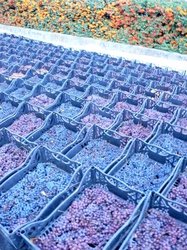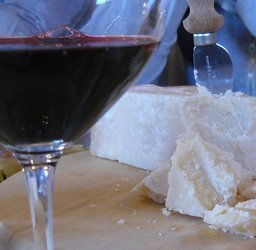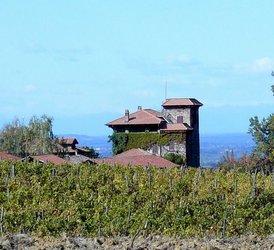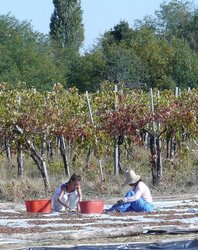This is the final post from Italy. Next stop: Provence!
My tour of Emilia-Romagna has taken me to more than a dozen wineries where I've encountered many wonderful people, tasted over 100 interesting wines, eaten fabulous meals and visited some of the world's most beautiful villages. Have now chronicled these events over the past couple of weeks, attempting to combine personal experiences with something of a global (rather than purely local) perspective on the wines. In addition to the hosts, wineries and restaurants already mentioned, I'd be remiss to omit the following.


At Montesissa in the hills above Piacenza, young Nicola Montesissa showed off the bins of recently harvested grapes destined for passito.


Lodovica Lusenti's winery in the Colli Piacentini avoids mainstream techniques. Her deep gold 2002 malvasia, partially aged in oak, was perfectly dry; her 2006 bonarda passito pruney and port-like. She's a bit of a rebel, but true to her own vision.


Two brothers at La Tosa: short, lively, generous Stefano Pizzamiglio is in charge of wine making (and hospitality). His tall, taciturn brother Ferruccio handles administration. A fine example of Gutturnio here (barbera-bonarda blend), and an elegant cabernet sauvignon with 18 months of barrel aging. The usual assortment of cold cuts (pancetta, salami, prosciutto, coppa), three kinds of quiche (potato-onion, spinach, vegetarian) and a big chunk of Grana Padana cheese. Sigh.



At Monte delle Vigne, veteran wine grower Andrea Ferrari took us on a long walk through the vineyards and poured his best wine, a barbera blend named for Verdi's famous opera, Nabucco. It's relegated to IGT status because it contains about 30% merlot, thus ineligible for the more prestigious DOC.


La Stoppa's wine maker, the dynamic Elena Pantaleoni, had just left on a sales trip to South America. The harvest was winding down; a couple of women were still sorting the ripest grapes for passito.


Umberto Cesari winery, one of many we visited in Emilia-Romagna, features a charismatic owner and a contented workforce (on lunch break when we stopped by).


Finally, though hardly least, Matteo Marenghi, wine expert for Emilia's hills, co-author of definitive varietal studies, married to an Englishwoman who runs a language school in Piacenza. (We've already described his counterpart for Romagna, Andrea Spada.) And my two "minders," marketing and media expert Marta Geri (of the multi-tentacled Ph5 Group advertising & PR agency) and freelance translator Elena Scheda. Sincere thanks and heartfelt gratitude, mille grazie, to all.














